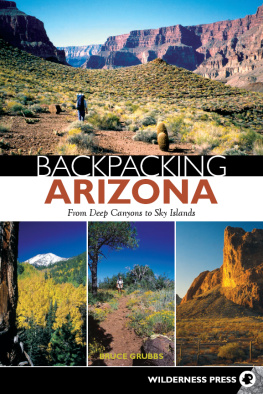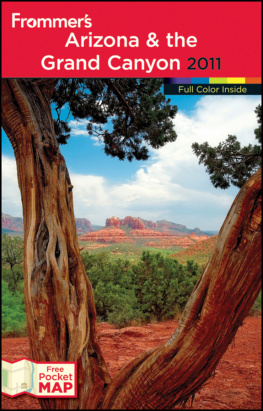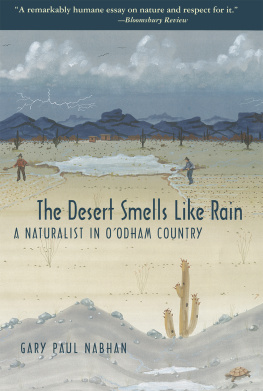Bruce Grubbs - Hiking Arizona
Here you can read online Bruce Grubbs - Hiking Arizona full text of the book (entire story) in english for free. Download pdf and epub, get meaning, cover and reviews about this ebook. publisher: Falcon Guides, genre: Home and family. Description of the work, (preface) as well as reviews are available. Best literature library LitArk.com created for fans of good reading and offers a wide selection of genres:
Romance novel
Science fiction
Adventure
Detective
Science
History
Home and family
Prose
Art
Politics
Computer
Non-fiction
Religion
Business
Children
Humor
Choose a favorite category and find really read worthwhile books. Enjoy immersion in the world of imagination, feel the emotions of the characters or learn something new for yourself, make an fascinating discovery.

- Book:Hiking Arizona
- Author:
- Publisher:Falcon Guides
- Genre:
- Rating:4 / 5
- Favourites:Add to favourites
- Your mark:
- 80
- 1
- 2
- 3
- 4
- 5
Hiking Arizona: summary, description and annotation
We offer to read an annotation, description, summary or preface (depends on what the author of the book "Hiking Arizona" wrote himself). If you haven't found the necessary information about the book — write in the comments, we will try to find it.
Hiking Arizona will introduce you to the states most natural wonders and more. This book covers the Grand Canyon, of course; Northeast Plateaus, San Francisco Peaks Area, Mogollon Rim Country; Central Highlands; The White Mountains; the Phoenix Area; the Tucson Area; Sky Islands; Tohono Oodham Country; and the Western Desert.
Hiking Arizona — read online for free the complete book (whole text) full work
Below is the text of the book, divided by pages. System saving the place of the last page read, allows you to conveniently read the book "Hiking Arizona" online for free, without having to search again every time where you left off. Put a bookmark, and you can go to the page where you finished reading at any time.
Font size:
Interval:
Bookmark:
Bruce Grubbs is an avid hiker, mountain biker, paddler, and cross-country skier who has been exploring the American West for decades. He has used high-technology gear in the backcountry in his work as a professional pilot, an amateur radio operator, and a mountain rescue team member. Bruce holds Airline Transport Pilot and Instrument Flight Instructor certificates. He lives in Flagstaff, Arizona, and is the author of more than thirty-five books.
Other books by the author:
Grand Canyon Guide
Exploring Great Basin National Park
Exploring with GPS
Hiking Northern Arizona
Best Easy Day Hikes Flagstaff
Best Easy Day Hikes Sedona
Hiking Arizonas Superstition and Mazatal County
Mountain Biking Phoenix
Mountain Biking Flagstaff and Sedona
Backpacker Magazines Using a GPS
Desert Hiking Tips
Hiking Nevada
Hiking Oregons Central Cascades
Mountain Biking St. George and Cedar City
For more information, check the authors website at brucegrubbs.com.
I would like to thank the many government employees who gave unselfishly of their time and expertise of the natural areas of Arizona. Here a just a few of those people:
Thanks to Joyce H. Wright, business manager, Arizona Strip Interpretive Association; Rick Best, chief interpreter, Navajo National Monument; and Joseph Spehar, Apache-Sitgreaves National Forests. And thanks to Forest Supervisor Conny J. Frisch, John Eavis, Charlotte Minor, and Wilderness Ranger John Neeling of Kaibab National Forest and Recreation Officer John Nelson and archaeologist Peter Pilles of Coconino National Forest.
Thanks to Fisheries Program Manager James R. Novy of the Arizona Game and Fish Department; Devin J. Wanner, public affairs specialist, Prescott National Forest; Dan Merritt, receptionist, and Beverly Blair and District Ranger Larry Widner, Globe Ranger District, Tonto National Forest. Thanks, too, to District Ranger Tom Bonomo, Verde Ranger District, Prescott National Forest; Frank Holmes, permit sales clerk, San Carlos Apache Tribe; and David Weir, information receptionist, Coronado National Forest. And thanks to Ron Morfin, Yuma Field Office, Bureau of Land Management (BLM); Bruce Asbjorn, outdoor recreation planner, BLM Kingman Field Office; Deputy State Director Michael Ferguson, BLM Resources Division; Ken Mahoney, Arizona BLM Wilderness Program Coordinator; and Park Ranger Jackie Price, Cibola National Wildlife Refuge.
Thanks also to my hiking friends who put up with my photography and trail mapping on hikes and backpack trips. And thanks to my friend and former coauthor, Stewart Aitchison, who originally suggested that we work together to produce a hiking guide to Arizona, for all the work he did on the first two editions of this book, as well as getting me started writing outdoor books. Special thanks to Duart Martin for her unflagging support of this project, especially during the final stages of editing and map preparation.
And finally, thanks to David Legere and the rest of the staff at FalconGuides for their patient efforts in making this new edition a reality.
Nearly 300 miles long and averaging 10 miles wide, the Grand Canyon is truly the master canyon of the Colorado Plateau. A lifetime can easily be spent exploring its depths. As you descend through the layered geology of the canyon, youll also be traveling southward in climate. On the South Rim mixed ponderosa pine and pion-juniper forest identify the transition life zone. Midway in your descent youll be passing through the upper Sonoran life zone, identifiable by its pygmy forest of junipers. Near the river youll be hiking in the lower Sonoran life zone, characterized by low desert shrubs and grasses. The North Rim of the canyon is formed by the south edge of the Kaibab Plateau, a scenic alpine plateau that is 8,000 to 9,000 feet in elevation. The plateau receives more rain and snow than the South Rim and so is covered with a forest of ponderosa pine, Douglas fir, and quaking aspen.

Spanish conquistadors under the command of Coronado, who rode north from Mexico City in 1540, were the first Europeans to visit the Grand Canyon. They reached the South Rim in 1542, most likely somewhere between the present Tanner and Grandview Trailheads. They spent a number of days trying to find a way to the Colorado River, without success. Undoubtedly their native guide knew of several routes but chose to keep the information to himself. More than 200 years would pass before Europeans would see the canyon again. During the 1820s mountain men roamed the Southwest in search of beaver, but apparently none of these intrepid explorers got below the rims of the canyon. Major John Wesley Powell carried out the first scientific exploration of the great canyon system on two Colorado River float trips between 1869 and 1871. His group, one of several government-sponsored surveys of the West, also extensively explored the region surrounding the canyon. Powell named the Grand Canyon and many of its features. After Powells explorations, miners and prospectors began to establish trails into the canyon. Most of them eventually found that guiding tourists into the canyon was more profitable than mining. This last wave of miners improved their trails to accommodate tourists, and many of their trails are still popular with hikers today.
Several hikes on the Kaibab Plateau are featured in this section. These are great hikes for summer or early fall, as the plateau is high enough to be pleasantly cool even during the hottest summer days. Several of the best hikes into the canyon also are featured. These routes are historic trails that have been abandoned and now receive only minimum maintenance. It is strongly suggested that hikers carry the appropriate topographic maps on these hikes, as sections of trail may not be obvious. The hikes listed are within Grand Canyon National Park, and overnight camping requires a permit that can be obtained from the backcountry office on the South Rim. Reservations can be made in person at the backcountry office or in advance by mail or fax. For information contact the National Park Service office listed under Trail contacts with each hike. Campfires are not allowed in the park backcountry, so plan to cook on a backpacking stove.
WHY GO?
This is an opportunity to experience a remote and rarely visited tributary of the Grand Canyon on an overnight backpack trip or very long day hike. The route through the Kanab Creek Wilderness follows a historic trail through interesting sandstone formations. Youll also have opportunities to explore nearby areas, including Jumpup and Kanab Canyons.
Start: 42 miles south of Fredonia
Distance: 9.6 miles out and back
Hiking time: About 6 hours
Difficulty: Strenuous
Trail surface: Dirt trails
Water: Upper Jumpup and Lower Jumpup Springs
Seasons: Mar through May and Sept through Nov
Other trail users: None
Canine compatibility: Dogs under control on leashes allowed in national forest; dogs not allowed in Grand Canyon National Park
Land status: Kanab Creek Wilderness, Kaibab National Forest
Nearest town: Fredonia
Fees and permits: None required for wilderness area; permit required if you continue south into Grand Canyon National Park
Nat Geo Topo! map: Grand Canyon West
Font size:
Interval:
Bookmark:
Similar books «Hiking Arizona»
Look at similar books to Hiking Arizona. We have selected literature similar in name and meaning in the hope of providing readers with more options to find new, interesting, not yet read works.
Discussion, reviews of the book Hiking Arizona and just readers' own opinions. Leave your comments, write what you think about the work, its meaning or the main characters. Specify what exactly you liked and what you didn't like, and why you think so.





